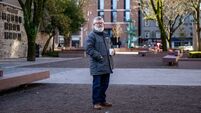We should all take a moment this Christmas to mourn children who died alone in mother and baby homes

There’s no ad on radio quite like the Barry’s Tea Christmas ad. I’m not a tea drinker, but I always insist on having a packet of Barry’s in the house, especially at this time of year.
You must know the ad. It’s been running for more than 20 years. I wait for it every year, because the instant I hear it, I’m six again.
The ad is about a father thrown back to his own childhood by the sound of a train set in a busy toy store. It reminds him of the moment he woke up on Christmas morning, and heard a sound he hadn’t dared hope for — his first train set, delivered by Santa Claus in the middle of a cold Christmas Eve night.
In my case, it was a scooter. I had seen it in a shop window in Bray, and I knew it was beyond reach. We’d just moved into a new house, and there had been whispered conversations between my parents about how we’d need to take in lodgers if we were ever going to be able to afford it. But things were on the up for my family — my father had just got a promotion in his job. (We didn’t know then that a terrible disaster would befall him when he left that job for another, but that’s a different story.)
The winter and Christmas of 1956 was white. White and cold. Bray was under inches of snow, and it was a wonderful time to be a child. Especially when that scooter arrived — there at the end of my bed when I woke up. Just like in the ad.
It’s the way Christmas should always be.
It’s not the way it always is.
A week after I got that scooter, and I can still remember the excitement of it, another little boy was buried in an unmarked grave, somewhere in Ireland. Peter Folan was his name. He was four months old when he died, and he was buried on December 29, 1956. Even though Bray was still freezing hard, I was out on my scooter every waking moment the day Peter was buried.
I don’t know who Peter Folan was, or where he is buried. I don’t know how he died. He was a baby in arms, but there were no arms to hold him. I know how cold it was then, how bleak a day it must have been when he was lowered into the ground. That’s all I know about him.
Yet I can’t get him out of my mind.
I know about him because I was doing the same thing that father is doing in the radio ad — rooting around the shops to see what Santa might bring my grandchildren for Christmas. I was hurrying back to the office with a few parcels when I came across Peter’s name, in the middle of Temple Bar.
It’s on a wall. Two walls actually, erected on a small plot of public land in the middle of what is, at any time of the year, a busy enough thoroughfare. It’s actually an art installation by a company called Farcry Productions. The yellow walls are covered with hundreds of children’s names, their ages, when they died, and they year in which they died. Below the names there are tiny squares of a silvery material, like the small plates on the top of coffins. The installation is called Somebody’s Child.
These are the children who died in mother and baby homes throughout Ireland — the ones whose names are known.

There’s a sign as part of the installation which says they were “buried in the dead of night with no priest, no cleric, no ritual, no mother beside them”.
I wrote down the rest of what it says, because these children are forgotten children. It’s part of the continuing injustice done to them that their names and existence have been so totally erased. As the message on Somebody’s Child says, these were children “unlucky enough to have been so ‘othered’ as to be denied the rites normally bestowed by decent society”.
They are not dim and distant history, these children. They shared my life, my time. While I was growing up a happy healthy child they grew up (and usually not for long, because they all died in childhood) in misery, cold, fear, and ill-health. The mothers from whom they were taken were forced to believe that their children had brought shame on them.
I stood in front of that wall for a long time, and I went back there yesterday morning to photograph some of the names. The names of these children stretch from the 1920s to the 1950s — 40 years of Irish life, hidden from our view.
“Somebody misses them still,” the sign says, “while they remain hidden in forbidden places guarded over by authorities who continue to deny closure to the living and the dead. We commit, for evermore, to remember these children as our very own flesh and blood. Our very own brothers and sisters. Family.”
Why would we not? Haven’t we moved past the point where we “other” children? Isn’t it impossible for us any more to see, and yet not see, children who are cold and hungry and afraid? Isn’t it surely the case that we will never again feel the need to erect a wall in our city centre because we have all forgotten what we did in the past?
I hope so. And yet I wonder. Children still suffer. We are waiting still for decent provision to be made for children in direct provision. It has been recommended and promised, but it hasn’t happened yet. We mourned the deaths of children in a traveller halting site earlier this year, but still we didn’t want the remaining children housed near us. Every week we read inspection reports about wholly inadequate residential facilities for children and vulnerable adults with intellectual disabilities, and we hope and assume that someone else, somewhere else, is doing something to make things better for them.
To paraphrase another popular ad, we’re not there yet. There are still children in Ireland who fit into the definition of “other” — children whom we choose not to see, because it’s just too uncomfortable.
I really want this Christmas, after long tough years of austerity, to be comfortable and happy for you and your children — and your grandchildren if you’re lucky enough to have them. If you have a minute over the holidays, and you happen to be in Dublin, walk down through Temple Bar until you come to Somebody’s Child.
Pick one of the names, any one at all. Philomena Healy, maybe. She died when just 11 months old in May 1929. Or Harry Leonard — he was three months old when he died in 1933. It’s hard to remember about all the children on the wall, but if you focus on just one, it will be hard to forget him or her.
They could have been our brother or sister. They could still, if we choose to remember. And then they won’t be part of the “other”.
At Christmas time, that’s the only gift we can give them. And maybe the best.














